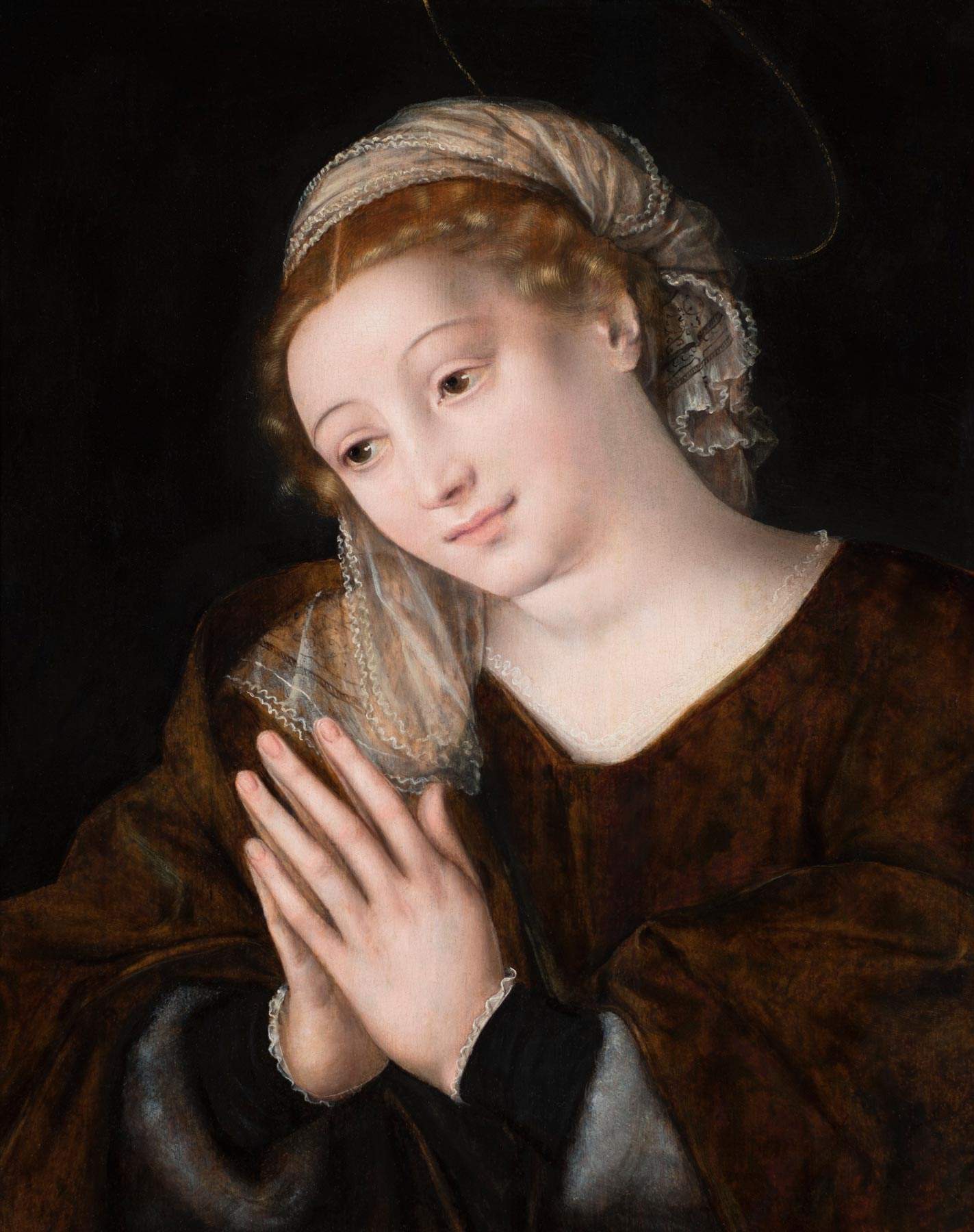An important painting by Jan Matsys (Antwerp, 1509 - 1575) has been acquired by theAbbey of San Giorgio Maggiore in Venice with the contribution of the nonprofit Benedicti Claustra: it is the Praying Virgin, an oil on panel dated 1552, which the Abbey purchased from the Caretto & Occhinegro Gallery in Turin. “The finalization of the purchase,” the gallery led by young Massimiliano Caretto and Francesco Occhinegro informs, “took place following meticulous negotiations, crowned with the delivery of the work to the Benedictine community that has always been the custodian of the Abbey of San Giorgio Maggiore in Venice and the Abbey of Praglia located in the vicinity of the city of Padua.”
The purchase, an important Flemish work, gives continuity to the cultural openness and interest in international art that has always been demonstrated in the Lagoon, ever since the collecting of the 16th century: in fact, Venice has always counted on the presence of Flemish works, which are still present in the city’s museums ( Hieronymus Bosch ’s Visions of the Afterlife at the Gallerie dell’Accademia are very famous). Jan Matsys is moreover a rare painter in Italy: his only works present in our country, three paintings, are all preserved at the Strada Nuova Museums in Genoa. The acquisition by the Abbey is therefore an exceptional event in terms of importance and specificity and is part of a larger project of international scope that aims to reconnect the ancient religious patronage tradition with the present, following the recent example of other public and ecclesiastical institutions.
The painting enjoys the unanimous attributive consensus of the international scholarly community and will soon be included in Matsys’ forthcoming catalog raisonné, edited by Maria Clelia Galassi. Universally recognized as one of the most relevant figures in 16th-century Flemish painting, son of the famous Quentin Matsys, Jan spent several years outside Flanders, where he returned only from 1555 onward (though alternating his residence in his homeland with several trips), until his death in 1575.
“Jan Matsys’ painting style,” Caretto and Occhinegro explain, “is among the most singular and characteristic of the entire period, capable of absorbing the most eclectic figurative experiences and in turn influencing some of the most widespread pre-Mannerist international languages. The ’strangeness’ of his style was matched by that of his life, which is still poorly documented and full of grey areas that make a clear chronological order of his works difficult, except on a stylistic basis and thanks to the rare signed works, which establish a terminus post quem to give a direction to his style: from the more traditional, paternally inspired one, gradually towards an increasing exacerbation of stylistic features, themes and expressive forms. By his predilection for female subjects and the way he treated them, Jan Massys can rightly be called the ’Flemish Cranach,’ the perfect example of that obsession with the female world and erotic themes that was typical of the highest international culture of the late Renaissance.”
"The Praying Virgin,“ the gallerists continue, ”is closely connected precisely to the pre-Anversese period, in which Jan’s style comes to life from his father’s, while revealing very early on certain typicalities that would never leave the author. The painting was conceived in pendant with a Christ Blessing, probably similar to the one now in the Kunstmuseum in Winterthur, Switzerland: it is a useful comparison for understanding the production of these devotional diptychs, which always included the Christ/Mary couple. However, the most interesting fact is the iconographic autonomy of the Virgin which, unlike Jan’s other paintings datable to the early period, does not turn out to be a copy/derivation from a paternal prototype, but rather one of the first completely autonomous conceptions, linking the painting directly to the first major works, such as the Madonna and Child preserved in the Palazzo Bianco in Genoa and dated 1552, the Adoration of the Child (of the same year) and the Caritas also preserved in Genoa. The female physiognomy is the same as in the above-mentioned paintings, as is the style of the hair, the hairstyle and the appearance of the embroidered veil: the stylistic comparison turns out to be so stringent that we can venture with relative certainty the date 1552 for the execution of our painting as well. If so, we would be dealing with a fundamental document in the author’s production, with an important addition to the catalog of Jan Matsys’ ’Genoese period’. As mentioned, the question of his relationship with Genoa is not entirely clear and, probably, related to his escape from Antwerp and his relations with those Gnostic-inspired cultural circles that, subterraneously, ran throughout sixteenth-century Europe. The great masterpieces, such as the Flora preserved today in Stockholm and bearing a detailed view of Genoa in the background, speak to us of a complex universe of symbolic and intellectual relationships that Jan exhibits insistently in his paintings, even through a deliberately allusive style."
“The work,” Caretto and Occhinegro conclude, “denounces the Massyssian imprinting in the slight hint of a smile, in the lyrical vividness of the eyes, animated by a shifting and enigmatic spirit, in the’tapered architecture of the almost boneless hands and, above all, in the porcelain complexion that characterizes the entire figure, as if one were in the presence of a statue infused with spirit and polished in that formal perfection that is the unmistakable hallmark of the Antwerp master.”
Image: Jan Matsys, Praying Virgin (1552; oil on panel, 44 x 56 cm)
 |
| Venice, San Giorgio Abbey acquires a rare painting by Jan Matsys |
Warning: the translation into English of the original Italian article was created using automatic tools. We undertake to review all articles, but we do not guarantee the total absence of inaccuracies in the translation due to the program. You can find the original by clicking on the ITA button. If you find any mistake,please contact us.